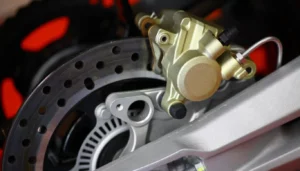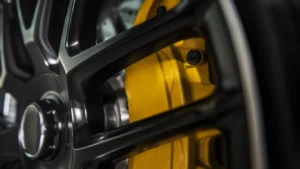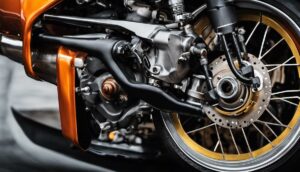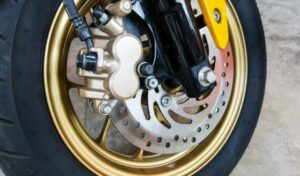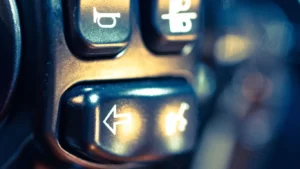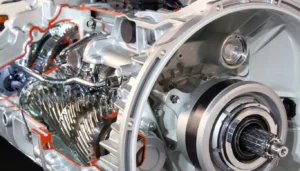It’s risky to ride a bike with a failed horn. It will put your and others’ lives in danger. I have seen such cases before; riding your motorcycle in the same situations will lead to accidents.
If your motorcycle horn is not working correctly and sounds like it needs to be replaced, I am here to help. I have dealt with similar situations, and you will get solutions and all the necessary information from here.
How Does A Motorcycle Horn Switch Work?
A motorcycle horn switch activates the driver’s side front brake. In most cases, this switch has two positions: convenient and emergency (or electric horn).
A motorcycle horn switch is also called a handlebar lever or horn handle. It is located on the right side of the bike, in front of the rider.
The horns are connected through an electric circuit inside the motorcycle.
When there is a signal from the turn signal light, the horn button switch activates the solenoid coil spring. The positive pole of this coil connects to the horn input terminal.
At the same time, the signal from the turn signal is sent to a negative output wire (ground), which completes the circuit for the horn output terminal.
A capacitor may be connected between this ground wire and another sensitive area (such as windows) for added sizzle.
Why Is My Motorcycle Horn Not Working?
If your motorcycle’s horn is not functioning properly, the most likely cause is a problem with the wiring, followed by a broken horn switch and a non-functioning horn delay.
Initially, you will get signs that soon your horn will stop working. It won’t die suddenly; at first, you will notice low sound intensity.
If you want to prevent yourself from getting sick, you should first understand the causes so that you can fix them yourself.
1. Bad Wiring
This is likely due to a loose connection or wire. To check this, turn the key on and off while checking the horn’s operation.
If it works, then your problem must be in the wiring. Your motorcycle horn may need to be fixed.
First, make sure that all of the connections to the horn switch and circuit breaker are in good shape. Check the fuse that controls the horns if the horn fails to sound when turned on or off.
If your motorcycle still doesn’t honk, it could be a more severe problem, such as corrosion of wires, damage from disconnecting a spark plug connection from an engine cylinder, or any other issue.
Ask your local motorcycle shop for assistance on this issue.
2. Faulty Horn Switch
If there is no issue with the wiring, move on to the second cause. You may have bought a faulty horn switch that isn’t suitable for your motorcycle.
You may check the horn switch using other testing methods if it is out of service.
Check them on the other bike’s connection or use external wiring to eliminate any doubts. Once you confront suspicion, change the horn switch.
Ask the nearby motorcycle mechanics if you need an idea of which switch would be better for your bike.
3. Dead Horn Relay
If you are using a horn relay for safety purposes, you must check the relay.
It will improve your output quality, and it is also a great idea to add separate wiring for the horn relay. Go through the same process; this may cause a problem while pressing the horn switch.
It has solutions; check the wiring, and if there is any issue, fix it first. If everything is in order, you may need to replace the old one.
4. Weak Battery
The horn will not work if it does not have a battery that is in good functioning condition. If the battery is almost dead, the horn probably won’t become any louder, but in the end, it won’t be of much use when you’re driving because it won’t be able to provide enough volume.
Follow These Simple Steps to Test Your Motorcycle Horn:
Are you excited to know how to test a motorcycle horn? With a few simple steps, you will gather the knowledge of whether it’s working or not, as mentioned below.
- You can test a motorcycle horn by placing the key in the ignition and turning it on. If the horn does not sound, the problem is most likely with the fuse box under which you will find a fuse that requires testing. If the horn still fails to work after this, there may be a loose connection inside of it.
- If you notice the clicking sound coming from the horn relay, it is a symptom that it has failed internally. Turn on the engine and press the switch; if it’s producing clicking sounds, it means the horn relay is faulty.
- Take a close view; if you can smell something burning underneath the horn relay, you should reconnect the wiring and remove it immediately. In some cases, the relay will start melting, so it’s advisable to replace it. Even after noticing the problem, visit the professional’s store if you need to gain experience with such cases.
Testing the horn on a motorcycle is easy as long as you have an external horn button. You can stop and turn it on and off, activating the horn signal.
To test the sound of your horn, hold the button down for about 3 seconds to get a good blast of sound.
If the engine still runs after you turn your engine off and restart it, then there’s nothing wrong with your horn. It’s time to ask for the technicians to inspect your two-wheeler.
What To Do When The Horn Is Not Working?
It sounds like a simple fix for the motorcycle horn. However, the common problem is that some horns are faulty. You may need to replace this component or repair it yourself.
You can do a few different things if your horn isn’t working. Try checking to see if a fuse is close to your horn to avoid blowing it because it is easy, cheap, and suitable for any vehicle.
Steps To Fix The Motorcycle Horn:
Fixing the motorcycle horn is easy if you know the exact reason. I still use a convenient way to repair the bike or its equipment. I’ll share those effortless but valuable tasks that will help you.
1. Fix the Wiring
As I mentioned above about the wiring issues, try to fix them if you find missing or incorrect wiring.
2. Start with the fuse
If you notice a problem associated with the fuse box, either repair it or replace it. It is a complicated process, so call the technicians if you still need to do it.
3. Replace Horn Switch or Relay
If everything is okay, it seems your horn is no longer working or you have a dead relay. Check each of them and replace them if both have become useless.
4. Repair or Replace Battery
It can be related to the battery. As headlights, horns, and indicators work on batteries, if you last changed the battery a long time ago, it’s a sign to change it or recharge it (if possible).
5. Another Issue
If nothing works, the last option is to leave your bike at the motorcycle repair shop. They will resemble the parts to find the actual reason and fix it with their advanced techniques and skills.
What Is A Horn Relay In A Motorcycle?
A horn relay is a small electronic device that controls the siren built into a motorcycle.
When the rider presses the horn button, the feedback is so loud that it hurts your ears.
When the horn switch is turned on, the horn relay sends power to a small speaker, which sends sound through the bike’s electrical system.
The horn relay has a unique control center that is in the headlight of your motorcycle. This controls how the horn works.
This also controls how often the horn is activated. The horn relay is located within the handlebars of a motorcycle.
It is used to turn on and off the output from the headlight, horn, or indicator LED. The owner can control this by pressing on the switch in the handlebar with their fingers and thumb.
Motorcycle horns are an important and necessary piece of safety equipment, but they can’t work without a relay.
The horn on your bike is powered by two 12-volt coil motors that create 120 volts of electricity.
Horns use current to send a loud blow to scare off would-be attackers. Each motor has its own coil, which powers a relay that controls the other motor to activate the horn.
Does A Motorcycle Horn Need A Relay?
The answer is yes; a motorcycle horn does need a relay. A horn relay is a safety device that cuts off the power to the electric motor inside the horn of a motorcycle.
Without the relay, your motorcycle’s horn won’t honk when it should, which could cause problems in dangerous situations like cutting across traffic or breaking down on an interstate highway.
Every motorcycle needs its share of relays because most bikes’ horns rely on a relay to turn the power on and off.
The relay is a mechanical device that sends a signal to an electronic device called a “horn control” to make or break electricity, depending on whether you want your horn to sound like a horn or not.
Modern motorcycle horns work like car horns, but instead of having physical switches, they have digital controls. They also look like classic motorcycle horns.
Conclusion
You have found all the answers that will save you from wasting your valuable money in this article. Follow the tips, keep your motorcycle horn sound, and have a safe and enjoyable journey.
If you find it helpful, subscribe to our newsletter, and don’t forget to share it with your friends or other bike lovers.

